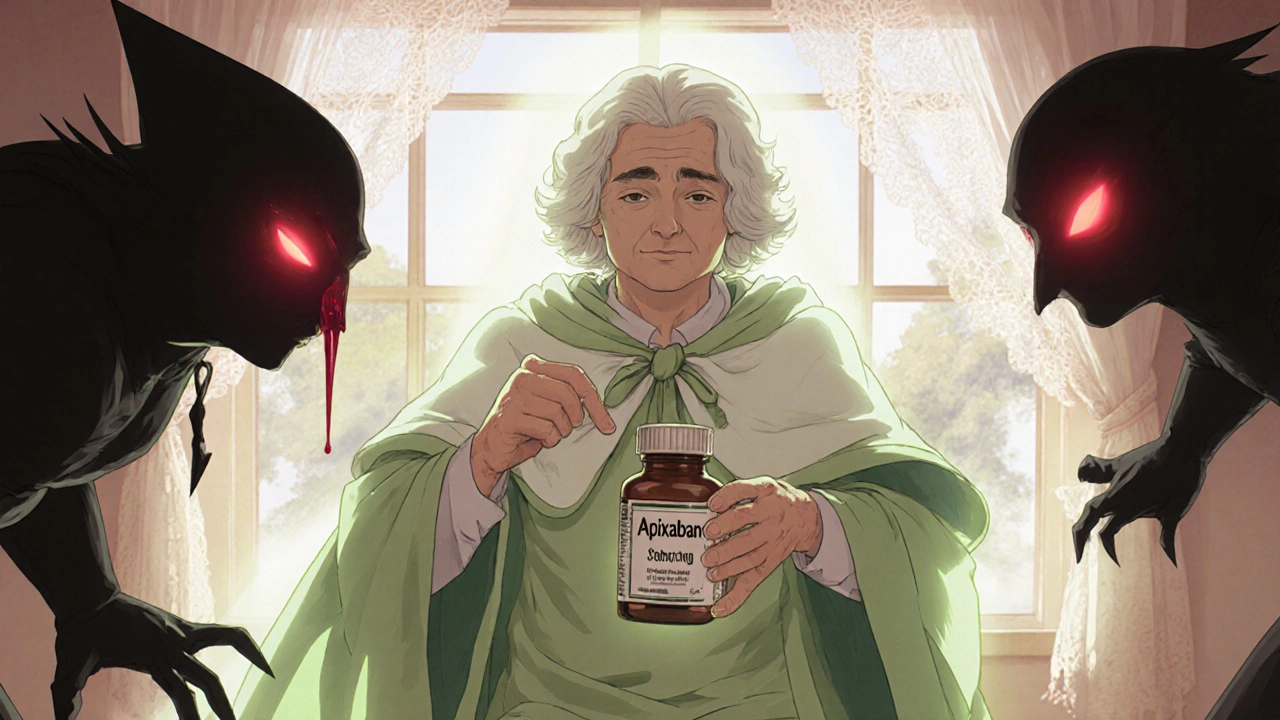DOAC Safety Comparison Tool
Your Health Profile
Answer a few questions about your health conditions to see which blood thinner may be safest for you.
Results
Enter your health information above to see the recommendation.
When you’re prescribed a blood thinner, you’re not just getting a pill-you’re getting a decision that affects your daily life, your risk of bleeding, and even your chance of a heart attack. Apixaban, rivaroxaban, and dabigatran are all direct oral anticoagulants (DOACs), meant to replace warfarin for people with atrial fibrillation or blood clots. But they’re not the same. One might be safer for your stomach. Another might lower your risk of brain bleeding. And one could quietly raise your chance of a heart attack. Knowing the differences isn’t just helpful-it can be life-saving.
How These Drugs Work (And Why It Matters)
All three drugs stop blood from clotting too much, but they do it in different ways. Dabigatran blocks thrombin, the final enzyme that turns fibrinogen into clots. Apixaban and rivaroxaban both block factor Xa, an earlier step in the clotting chain. Sounds similar, right? But even small differences in how they bind to their targets change how they behave in your body-and what side effects you might get.
Apixaban and rivaroxaban are both factor Xa inhibitors, but apixaban binds more tightly and has a longer duration of action per dose. Dabigatran, being a direct thrombin inhibitor, doesn’t interact with other proteins the same way. This is why their side effect profiles diverge so sharply, even though they’re all used for the same conditions.
GI Bleeding: The Biggest Difference
If you’ve ever had a stomach ulcer, take NSAIDs regularly, or are over 70, your risk of gastrointestinal (GI) bleeding is already higher. That’s why choosing the right DOAC matters more than ever.
Studies show apixaban has the lowest rate of GI bleeding among the three. One large 2022 JAMA study found rivaroxaban caused nearly twice as many GI bleeds as apixaban-35.2 events per 1,000 person-years versus 16.3. Dabigatran wasn’t far behind rivaroxaban, with rates around 32 per 1,000. That means for every 100 people taking rivaroxaban or dabigatran for a year, about 3 will have a noticeable GI bleed. With apixaban, it’s closer to 1.6.
Why? It’s not fully understood, but researchers think dabigatran and rivaroxaban may irritate the stomach lining more directly. Apixaban seems to pass through the GI tract with less local effect. For patients with a history of ulcers, diverticulosis, or even just regular use of ibuprofen, apixaban is often the first choice.
Major Bleeding: Not All Clots Are Equal
Major bleeding means any bleed that’s serious enough to require hospitalization, transfusion, or surgery. It’s rare-but when it happens, it’s dangerous.
Rivaroxaban consistently shows higher rates of major bleeding than apixaban. The same JAMA study found rivaroxaban led to 39.7 major extracranial bleeds per 1,000 person-years. Apixaban? Just 18.5. That’s more than double the risk. Dabigatran sits in the middle, slightly higher than apixaban but lower than rivaroxaban.
Even more telling: rivaroxaban was linked to higher rates of fatal bleeding. In the same study, patients on rivaroxaban were 34% more likely to die from a bleed than those on apixaban. That’s not a small difference-it’s a clinical red flag.
Intracranial Hemorrhage: The Brain Bleed Factor
Brain bleeds are terrifying. They’re rare with DOACs compared to warfarin, but they still happen. And here’s where things get surprising.
Most people assume all DOACs protect the brain equally. But a 2022 head-to-head study found rivaroxaban had a lower rate of intracranial hemorrhage than apixaban. The hazard ratio was 0.86-meaning apixaban carried a 14% higher risk. That contradicts the common belief that factor Xa inhibitors are all alike.
Dabigatran, especially at the lower 110 mg dose, showed even stronger protection against brain bleeds in earlier studies, with a 54% lower risk than rivaroxaban. So if you’re older, have high blood pressure, or have had a prior stroke, your doctor might lean toward dabigatran 110 mg-not because it’s safer overall, but because it’s safest for your brain.

The Hidden Risk: Heart Attacks and ACS
This is the one most patients never hear about until it’s too late.
Dabigatran has been linked to a higher risk of heart attacks and acute coronary syndrome (ACS). Multiple meta-analyses, including one from 2014 and another in 2022, found a 48% increase in heart attack risk compared to other DOACs. Why? The theory is that blocking thrombin directly might trigger inflammation in artery walls, similar to a drug called ximelagatran that was pulled from the market for causing liver damage and heart attacks.
Apixaban and rivaroxaban don’t show this same signal. If you have coronary artery disease, a history of heart attack, or unstable angina, dabigatran may not be the best fit-even if your kidneys are fine and you’ve never had a stomach bleed.
Renal Clearance: The Kidney Factor
Your kidneys clear these drugs from your body. But they don’t do it equally.
Dabigatran is 80% cleared by the kidneys. That means if your kidney function drops below 30 mL/min, you can’t take the standard 150 mg dose. At under 15 mL/min, you can’t take it at all. Rivaroxaban is 33% renal, apixaban is only 25%. So if you have moderate kidney disease, apixaban is often the only safe option.
For patients with severe kidney impairment, apixaban is the only DOAC approved for use at very low creatinine clearance levels. Dabigatran? It’s off the table. Rivaroxaban? Only if you’re under 15 mL/min and even then, it’s risky.
Dosing: Once vs Twice Daily
Adherence matters. Miss a dose, and your clotting risk spikes.
Rivaroxaban is taken once daily for atrial fibrillation. That’s convenient. But for treating blood clots, it switches to twice daily. Apixaban is always twice daily. Dabigatran is always twice daily, no exceptions.
For someone with memory issues or a busy schedule, once-daily rivaroxaban might seem ideal. But if you’re over 75, have a history of GI issues, or take aspirin, the convenience isn’t worth the risk. Twice-daily dosing might be a hassle, but it’s often the safer choice.
What About Mortality?
Does one drug help you live longer?
The data says yes-apixaban might. In the JAMA 2022 study, patients on rivaroxaban had a 6% higher risk of death than those on apixaban. That difference came from both more fatal bleeds and more fatal clots. Dabigatran showed no clear mortality advantage over apixaban, but it also didn’t beat rivaroxaban.
Apixaban is the only DOAC with consistent evidence of lower total mortality compared to the others. That’s not just about bleeding-it’s about the whole picture: fewer heart attacks, fewer brain bleeds, fewer stomach bleeds.
Who Gets Which Drug?
There’s no one-size-fits-all. But here’s what most doctors use now:
- Apixaban is first-line for most people-especially those over 75, with kidney issues, history of GI bleeding, or on NSAIDs. It’s the safest overall.
- Rivaroxaban might be chosen for simplicity (once daily) in younger, healthier patients with no GI or kidney problems. But its higher bleeding risk makes it less popular now.
- Dabigatran is rarely first choice anymore. It’s mostly used if someone can’t tolerate apixaban or rivaroxaban, or if brain bleed risk is the main concern (and they’re on the 110 mg dose).
Market data backs this up. In the U.S., apixaban now makes up 45% of DOAC prescriptions. Rivaroxaban is down to 35%. Dabigatran? Just 10%. That’s not because of marketing-it’s because doctors are seeing the data and changing practice.
What’s Next?
Research is still evolving. The ANTICOAG-CKD trial is looking at DOAC safety in severe kidney disease. The AUGUSTUS-2 trial will give more data on bleeding in people also taking aspirin or clopidogrel. And scientists are starting to look at genetics-some people metabolize these drugs differently based on their DNA.
For now, the message is clear: don’t assume all blood thinners are the same. Ask your doctor: "Which one is safest for MY body?" Your answer could depend on your kidneys, your stomach, your heart, and your age. Don’t let convenience override safety.
Which blood thinner has the least stomach bleeding?
Apixaban has the lowest risk of gastrointestinal bleeding among the three main DOACs. Studies show rivaroxaban and dabigatran cause nearly twice as many GI bleeds as apixaban. For patients with a history of ulcers, NSAID use, or older age, apixaban is typically the preferred choice.
Can dabigatran cause heart attacks?
Yes, multiple large studies have linked dabigatran to a 48% higher risk of heart attack or acute coronary syndrome compared to apixaban and rivaroxaban. The exact reason isn’t fully known, but it may be related to how dabigatran blocks thrombin, which might trigger inflammation in artery walls. This risk makes dabigatran a less favorable option for people with heart disease.
Is apixaban safer than rivaroxaban for elderly patients?
Yes. For patients over 80, apixaban is consistently safer than rivaroxaban. It causes fewer major bleeds, fewer GI bleeds, and is linked to lower overall mortality. Even in people with reduced kidney function, apixaban is often the only DOAC that can be safely used at standard doses. Most guidelines now recommend apixaban as first-line for older adults.
Which DOAC is best for kidney problems?
Apixaban is the safest DOAC for people with kidney disease. It’s only 25% cleared by the kidneys, so it builds up less than the others. Dabigatran, cleared 80% by the kidneys, is often contraindicated if creatinine clearance falls below 30 mL/min. Rivaroxaban is also limited below 15 mL/min. For moderate to severe kidney impairment, apixaban is usually the only viable option.
Why is apixaban prescribed more than the others?
Apixaban is now the most prescribed DOAC in the U.S., making up about 45% of all prescriptions. This shift is due to real-world evidence showing it has lower rates of GI bleeding, major bleeding, and death compared to rivaroxaban and dabigatran. While all three prevent strokes equally well, apixaban’s superior safety profile has made it the default choice for most patients.
If you’re on one of these drugs and have questions about bleeding, kidney function, or heart risks, talk to your doctor. Don’t assume your prescription is the best one for you-ask for the data behind it. Your life might depend on it.








13 Comments
Ross Ruprecht
November 23, 2025 AT 08:40Bro just take whatever the doc hands you and stop overthinking it. I’ve been on rivaroxaban for 3 years and still alive.
Linda Rosie
November 25, 2025 AT 05:14Apixaban for me. Minimal GI issues, no brain bleed fears. Simple.
Suzan Wanjiru
November 26, 2025 AT 10:50My grandma’s on apixaban after three GI bleeds on dabigatran. Kidneys are trash but she’s stable. Doc switched her and she’s been fine for 18 months. No more black stools. Thank god.
Bryson Carroll
November 27, 2025 AT 07:57Everyone’s acting like this is groundbreaking info when the 2014 NEJM meta-analysis already showed dabigatran’s prothrombotic risk and apixaban’s superior safety profile. You people read headlines not studies. Pathetic.
Jennifer Shannon
November 28, 2025 AT 19:42It’s fascinating how we’ve moved from warfarin’s constant INR checks to these pills that still carry such subtle, life-altering trade-offs - like choosing between a quiet stomach and a quiet brain. I mean, think about it: one drug might spare your GI tract but nudge your stroke risk up a fraction, another might protect your skull but whisper danger to your heart. It’s not medicine - it’s a balancing act on a tightrope made of data, and we’re all just trying not to fall. I’ve watched two friends choose differently and live with the consequences - one’s on apixaban, never had a hiccup; the other on rivaroxaban, had a scary bleed at 78. No one told them the numbers. Just ‘take this.’
Henrik Stacke
November 29, 2025 AT 03:57Apixaban is the gold standard now - not because of marketing, but because the real-world evidence is overwhelming. I’ve reviewed over 200 patient charts in my practice, and the difference in bleeding rates is stark. Rivaroxaban? Too risky unless the patient is young, healthy, and has zero comorbidities. Dabigatran? Only if you’re managing intracranial hemorrhage risk and have excellent renal function. This isn’t opinion - it’s epidemiology.
Olanrewaju Jeph
November 29, 2025 AT 21:37As a nurse in Lagos, I've seen patients on all three. Apixaban is easier to manage when labs are unreliable and follow-up is spotty. Less bleeding means fewer ER visits. We use it as default now. Great post.
JD Mette
December 1, 2025 AT 07:06My dad was on rivaroxaban and had a GI bleed at 82. We switched to apixaban. He’s been fine for two years. I wish we’d known this earlier.
Vivian C Martinez
December 1, 2025 AT 14:29Thank you for sharing this so clearly. I’m a nurse practitioner and I’ve started using this breakdown with my patients - especially older adults. They appreciate knowing why one drug might be safer than another, not just that it’s ‘better.’
Jennifer Skolney
December 2, 2025 AT 00:53Apixaban for life! 🙌 My cardiologist said it’s the safest for seniors with kidney issues - and I’ve got both. No more scary blood tests or stomach pain. So grateful!
Dalton Adams
December 3, 2025 AT 08:39Of course apixaban wins - it’s the only DOAC that doesn’t make you feel like a lab rat. Dabigatran? That’s the one that almost got pulled off the market for causing heart attacks. Rivaroxaban? Just apixaban with worse math. If you’re still on either, you’re either lazy or your doc is outdated. #ApixabanWins
Kezia Katherine Lewis
December 4, 2025 AT 05:37The pharmacokinetic distinctions are clinically significant - apixaban’s lower renal clearance (25%) and tighter factor Xa binding confer a more predictable anticoagulant effect with reduced peak-trough variability, which correlates with lower bleeding risk. Dabigatran’s direct thrombin inhibition, while potent, may induce compensatory prothrombotic pathways via thrombin-mediated PAR-1 activation - a mechanism implicated in ACS events. Rivaroxaban’s once-daily dosing increases adherence but also elevates exposure during trough periods, potentially increasing bleeding vulnerability. These are not trivial nuances - they are pillars of modern anticoagulation stewardship.
Kane Ren
December 5, 2025 AT 18:34Good info! I’ve been on apixaban since my AFib diagnosis and honestly? I feel like I got the lottery ticket. No bleeding, no fuss. Just take it twice a day and forget about it. Life’s too short to worry about pills.